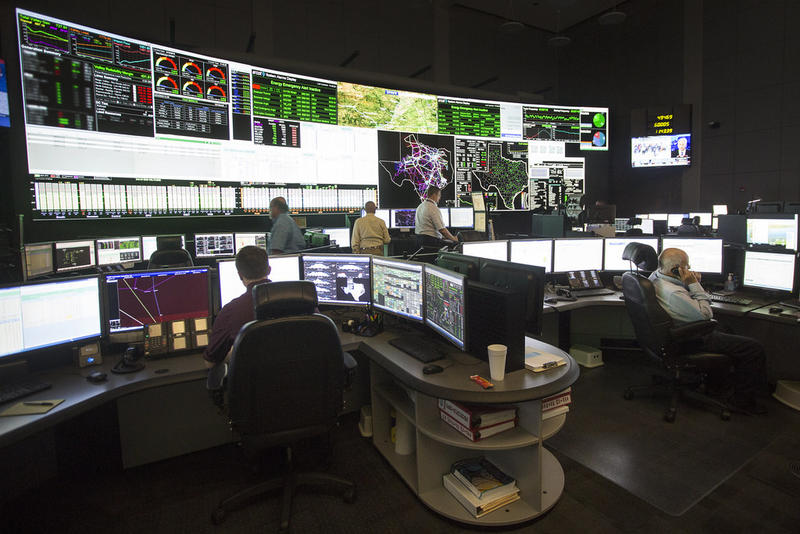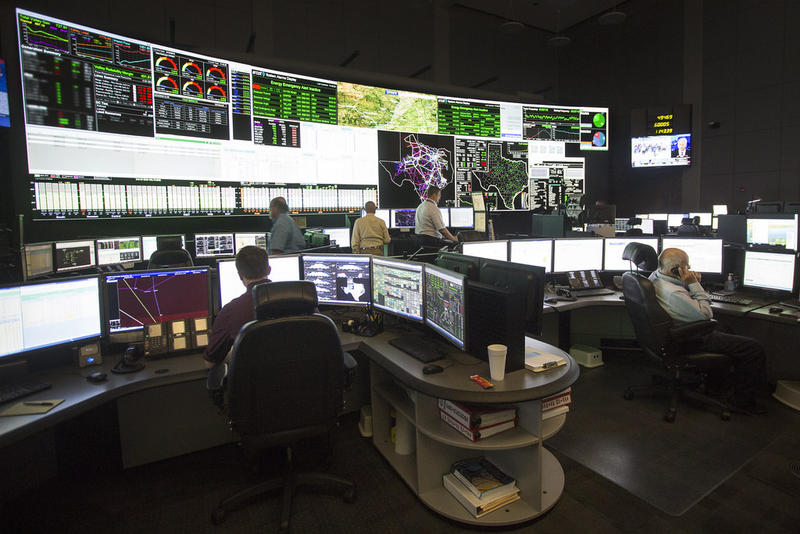ERCOT’s permitting process for interconnecting large industrial energy users to the power grid has slowed the expansion of crypto mining operations in the state. It’s also created a framework for managing their energy consumption.
By September 2, 2022 11:28 amBusiness & Your Money, Energy & Environment, Texas Standard Original

Julia Reihs / KUT
The Electric Reliability Council of Texas manages the electric grid and power for 24 million Texans.
Cryptocurrency miners have flocked to Texas in recent years. But a downturn in the crypto market, along with a new permitting process aimed at managing power consumption more effectively, mean it’s taking longer for projects to get approved. Does all this mean the crypto boom in Texas is over?
Eliza Gkritsi, is a mining reporter for CoinDesk, told Texas Standard that the state’s approach to regulating energy use in the crypto market could eventually provide a blueprint for such regulation around the world. Listen to the interview above or read the transcript below.
This transcript has been edited lightly for clarity:
Texas Standard: A year or so ago, we were reporting here on the Standard about crypto miners leaving China and other places, and flocking to Texas because of cheap, abundant energy – and of course, lighter regulations than in many other parts of the world. What’s changed?
Eliza Gkritsi: A lot has changed in crypto. The price of Bitcoin is not where it was at least six months ago. A lot has changed in Texas as well. There is energy still in Texas, but it’s not perhaps so readily available. It’s the type of energy that you would need to spend more money and time getting to and using. And I think also just the very fact that so many miners went to Texas kind of changed how the grid operator and perhaps even the utilities commission looks at the industry.
It’s my understanding that the Electric Reliability Council of Texas recently wrote some new rules on energy consumption, and that may be affecting the Bitcoin mining industry.
In March, what’s called the Large Flexible Load Task Force installed an interim process for interconnecting to the grid. That’s when you want to plug in to the grid to get energy for industrial uses. But that new permitting process meant that it’s just been kind of slower for people to get connected to the grid, which is perhaps upsetting to some that were sort of promised a lot of things. And even when it was instituted, perhaps they weren’t expected that it would be quite so slow.
But I think it’s important to understand that it’s not that ERCOT has said, “we don’t want mining” or other types of large flexible loads. I think it’s more that they are trying to figure out exactly how to make that part of the grid in a useful way for everyone. And while they’re figuring out these rules, which do not exist anywhere in the world, they perhaps were like, “OK, we need to slow down,” because their numbers say 33 gigawatts of mining wants to be connected to the Texas grid, which is a lot of energy.
Well, I think that when Bitcoin operators first began to arrive in Texas en masse, there were a lot of people – especially state officials – sort of celebrating, “look what we’ve created here with the costs and the low regulation.” Are mining operations actually pulling out of Texas because of this new permitting scheme or the rising cost of energy or how do you see it shaking down?
I don’t think people exactly are pulling out yet. I can see the scenario in which, if you had invested some money or were planning to invest like several million dollars on having like a 500 megawatt facility, and it’s been a year since you’ve applied for interconnection and you don’t have it yet, perhaps then we would see people pulling out of Texas. But I think overall, the people that sort of did make those commitments have not started pulling out. Like everybody – ERCOT, I think also the governor of Texas and the miners – do want to make this work because Texas does have a lot of energy and a lot of other benefits.
The headline of your story says that it’s the end of the Bitcoin mining gold rush in Texas – perhaps a bit of hyperbole, or how do you see it?
I think a lot of people kind of misread that, and I can see why. But for me, the emphasis is more on the rush. I think what we’re going to see now is sort of slower investment, like mature investors being in the space, people who are willing to wait one year, 18 months for their projects to come to fruition and be operational. ERCOT is going to play a large role in figuring out these rules, figuring out how miners can be an asset to the grid, and if they do a good job of that, that’s going to be used as a blueprint for other grids around the world. And that’s really exciting in a way.
If you found the reporting above valuable, please consider making a donation to support it here. Your gift helps pay for everything you find on texasstandard.org and KUT.org. Thanks for donating today.
Julia Reihs / KUT
The Electric Reliability Council of Texas manages the electric grid and power for 24 million Texans.
Cryptocurrency miners have flocked to Texas in recent years. But a downturn in the crypto market, along with a new permitting process aimed at managing power consumption more effectively, mean it’s taking longer for projects to get approved. Does all this mean the crypto boom in Texas is over?
Eliza Gkritsi, is a mining reporter for CoinDesk, told Texas Standard that the state’s approach to regulating energy use in the crypto market could eventually provide a blueprint for such regulation around the world. Listen to the interview above or read the transcript below.
This transcript has been edited lightly for clarity:
Texas Standard: A year or so ago, we were reporting here on the Standard about crypto miners leaving China and other places, and flocking to Texas because of cheap, abundant energy – and of course, lighter regulations than in many other parts of the world. What’s changed?
Eliza Gkritsi: A lot has changed in crypto. The price of Bitcoin is not where it was at least six months ago. A lot has changed in Texas as well. There is energy still in Texas, but it’s not perhaps so readily available. It’s the type of energy that you would need to spend more money and time getting to and using. And I think also just the very fact that so many miners went to Texas kind of changed how the grid operator and perhaps even the utilities commission looks at the industry.
It’s my understanding that the Electric Reliability Council of Texas recently wrote some new rules on energy consumption, and that may be affecting the Bitcoin mining industry.
In March, what’s called the Large Flexible Load Task Force installed an interim process for interconnecting to the grid. That’s when you want to plug in to the grid to get energy for industrial uses. But that new permitting process meant that it’s just been kind of slower for people to get connected to the grid, which is perhaps upsetting to some that were sort of promised a lot of things. And even when it was instituted, perhaps they weren’t expected that it would be quite so slow.
But I think it’s important to understand that it’s not that ERCOT has said, “we don’t want mining” or other types of large flexible loads. I think it’s more that they are trying to figure out exactly how to make that part of the grid in a useful way for everyone. And while they’re figuring out these rules, which do not exist anywhere in the world, they perhaps were like, “OK, we need to slow down,” because their numbers say 33 gigawatts of mining wants to be connected to the Texas grid, which is a lot of energy.
Well, I think that when Bitcoin operators first began to arrive in Texas en masse, there were a lot of people – especially state officials – sort of celebrating, “look what we’ve created here with the costs and the low regulation.” Are mining operations actually pulling out of Texas because of this new permitting scheme or the rising cost of energy or how do you see it shaking down?
I don’t think people exactly are pulling out yet. I can see the scenario in which, if you had invested some money or were planning to invest like several million dollars on having like a 500 megawatt facility, and it’s been a year since you’ve applied for interconnection and you don’t have it yet, perhaps then we would see people pulling out of Texas. But I think overall, the people that sort of did make those commitments have not started pulling out. Like everybody – ERCOT, I think also the governor of Texas and the miners – do want to make this work because Texas does have a lot of energy and a lot of other benefits.
The headline of your story says that it’s the end of the Bitcoin mining gold rush in Texas – perhaps a bit of hyperbole, or how do you see it?
I think a lot of people kind of misread that, and I can see why. But for me, the emphasis is more on the rush. I think what we’re going to see now is sort of slower investment, like mature investors being in the space, people who are willing to wait one year, 18 months for their projects to come to fruition and be operational. ERCOT is going to play a large role in figuring out these rules, figuring out how miners can be an asset to the grid, and if they do a good job of that, that’s going to be used as a blueprint for other grids around the world. And that’s really exciting in a way.
If you found the reporting above valuable, please consider making a donation to support it here. Your gift helps pay for everything you find on texasstandard.org and KUT.org. Thanks for donating today.
©2021 Texas Standard. A service of the Moody College of Communication at the University of Texas at Austin | Contact us


